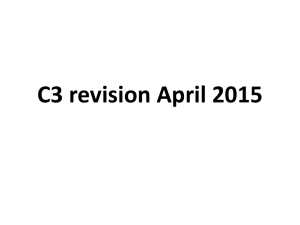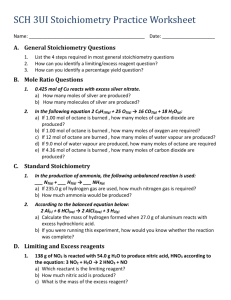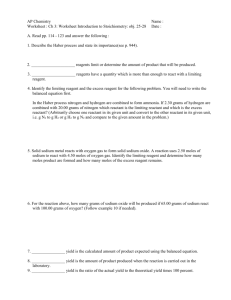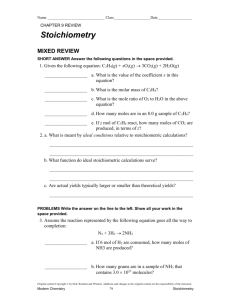SCH 3A Unit 4: The Mole & Stoichiometry Practice Test
advertisement
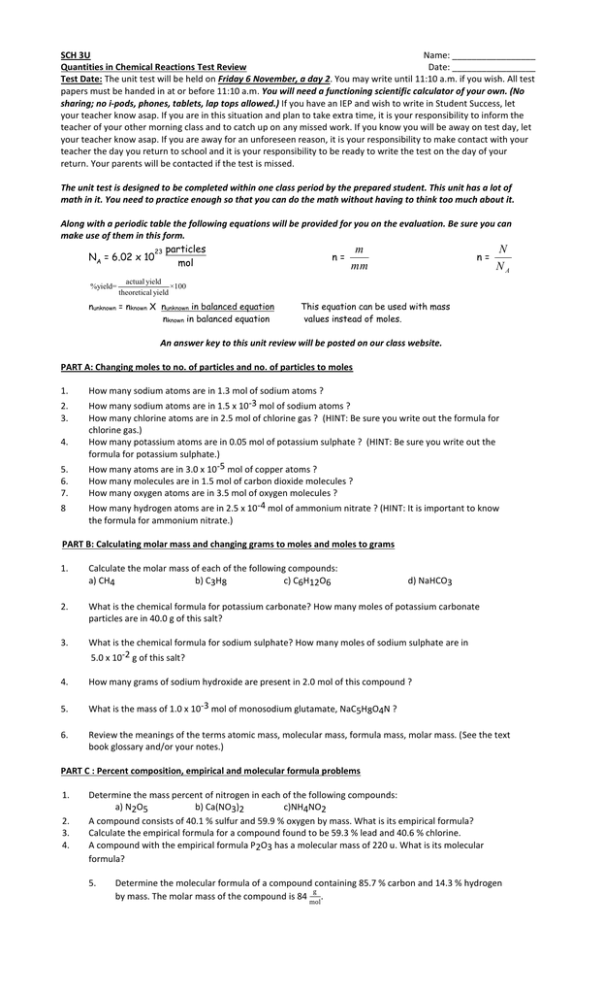
SCH 3U Name: _________________ Quantities in Chemical Reactions Test Review Date: _________________ Test Date: The unit test will be held on Friday 6 November, a day 2. You may write until 11:10 a.m. if you wish. All test papers must be handed in at or before 11:10 a.m. You will need a functioning scientific calculator of your own. (No sharing; no i-pods, phones, tablets, lap tops allowed.) If you have an IEP and wish to write in Student Success, let your teacher know asap. If you are in this situation and plan to take extra time, it is your responsibility to inform the teacher of your other morning class and to catch up on any missed work. If you know you will be away on test day, let your teacher know asap. If you are away for an unforeseen reason, it is your responsibility to make contact with your teacher the day you return to school and it is your responsibility to be ready to write the test on the day of your return. Your parents will be contacted if the test is missed. The unit test is designed to be completed within one class period by the prepared student. This unit has a lot of math in it. You need to practice enough so that you can do the math without having to think too much about it. Along with a periodic table the following equations will be provided for you on the evaluation. Be sure you can make use of them in this form. m N 23 particles NA = 6.02 x 10 n= n= mol mm N A actual yield %yield= ×100 theoretical yield nunknown = nknown X nunknown in balanced equation nknown in balanced equation This equation can be used with mass values instead of moles. An answer key to this unit review will be posted on our class website. PART A: Changing moles to no. of particles and no. of particles to moles 1. 2. 3. 4. 5. 6. 7. 8 How many sodium atoms are in 1.3 mol of sodium atoms ? How many sodium atoms are in 1.5 x 10-3 mol of sodium atoms ? How many chlorine atoms are in 2.5 mol of chlorine gas ? (HINT: Be sure you write out the formula for chlorine gas.) How many potassium atoms are in 0.05 mol of potassium sulphate ? (HINT: Be sure you write out the formula for potassium sulphate.) How many atoms are in 3.0 x 10-5 mol of copper atoms ? How many molecules are in 1.5 mol of carbon dioxide molecules ? How many oxygen atoms are in 3.5 mol of oxygen molecules ? How many hydrogen atoms are in 2.5 x 10-4 mol of ammonium nitrate ? (HINT: It is important to know the formula for ammonium nitrate.) PART B: Calculating molar mass and changing grams to moles and moles to grams 1. Calculate the molar mass of each of the following compounds: a) CH4 b) C3H8 c) C6H12O6 d) NaHCO3 2. What is the chemical formula for potassium carbonate? How many moles of potassium carbonate particles are in 40.0 g of this salt? 3. What is the chemical formula for sodium sulphate? How many moles of sodium sulphate are in 5.0 x 10-2 g of this salt? 4. How many grams of sodium hydroxide are present in 2.0 mol of this compound ? 5. What is the mass of 1.0 x 10-3 mol of monosodium glutamate, NaC5H8O4N ? 6. Review the meanings of the terms atomic mass, molecular mass, formula mass, molar mass. (See the text book glossary and/or your notes.) PART C : Percent composition, empirical and molecular formula problems 1. 2. 3. 4. Determine the mass percent of nitrogen in each of the following compounds: a) N2O5 b) Ca(NO3)2 c)NH4NO2 A compound consists of 40.1 % sulfur and 59.9 % oxygen by mass. What is its empirical formula? Calculate the empirical formula for a compound found to be 59.3 % lead and 40.6 % chlorine. A compound with the empirical formula P2O3 has a molecular mass of 220 u. What is its molecular formula? 5. Determine the molecular formula of a compound containing 85.7 % carbon and 14.3 % hydrogen g by mass. The molar mass of the compound is 84 . mol PART D: Mole Ratios & "Mass-to-mass" problems 1. Answer the following questions given the balanced chemical equation below. 6 H2O(l) + 6 CO2(g) ------> C6H12O6(s) + 6 O2(g) a) How many moles of glucose are produced if i) 6 moles of carbon dioxide are used in the reaction ? ii) 12 moles of carbon dioxide are used in the reaction ? iii) 0.25 moles of carbon dioxide are used in the reaction ? b) If 60 moles of water and 120 moles of carbon dioxide are available, how many moles of each one will actually be used in the reaction? How many moles of glucose will be formed? 2. The reaction between ammonia and oxygen is one step in the industrial preparation of nitric acid: 4 NH3(g) + 5 O2(g) -----> 4 NO(g) + 6 H2O(g) If we use 6.80 g of ammonia, what mass of oxygen will be required to consume all of the ammonia? 3. Hydrogen gas and oxygen gas combine explosively to form liquid water. Calculate the mass of oxygen gas needed to completely convert 5.00 g of hydrogen gas to water. 4. Define the term stoichiometry. (Use your text book glossary.) PART E: Limiting Reagent Problems 1. Zinc and bromine react readily to form zinc bromide according to the balanced equation Zn(s) + Br2(l) ZnBr2(s) a) Assume 1.00 g of bromine and1.00 g of zinc are available for reaction. Which of these substances is the limiting reagent? b) Calculate how much zinc bromide will be produced. 2. Given that 2 Na(s) + Cl2(g) 2 NaCl(s) What mass of sodium chloride would be expected if 0.460 g of sodium and 0.426 g of chlorine are placed in a reaction vessel? [Note – Because you are given information about both reactants and asked about the product, this is a limiting reagent problem.] 3. Why is it important to use the information relating to the limiting reagent when trying to determine how much product will be formed? PART F: Percentage Yield Problems 1. Define the following terms: limiting reagent, reagent in excess, theoretical yield, actual yield percent yield. (See your notes and apge 238.) 2. If 189 g of lead (II) sulphide was actually obtained in a reaction for which the theoretical yield was 239 g. Calculate the percentage yield. 3. Use the balanced equation from question 2 of part E when answering the following question. If 8.30 g of sodium and 14.0 g of chlorine are heated together, a total of 19.5 g of sodium chloride is isolated. [Note: This means that the actual yield of NaCl(s) is 19.5 g in the lab under these conditions.] a) Which of the reactants is the limiting reagent? Show your work. b) Calculate the theoretical yield of sodium chloride. c) Determine the percentage yield of sodium chloride. 4. Describe at least two reasons why a) a theoretical yield might be larger than an actual yield. b) a theoretical yield might be smaller than an actual yield. Note: “Experimental error” or “human error” are not specific enough answers. See pages 314 – 316 if needed. Want more review? Your textbook has unit review questions on pages 339 – 345. Many of the answers to text problems are in the back of the textbook. Preparing early means you can also bring any problems to your teacher before test day.


